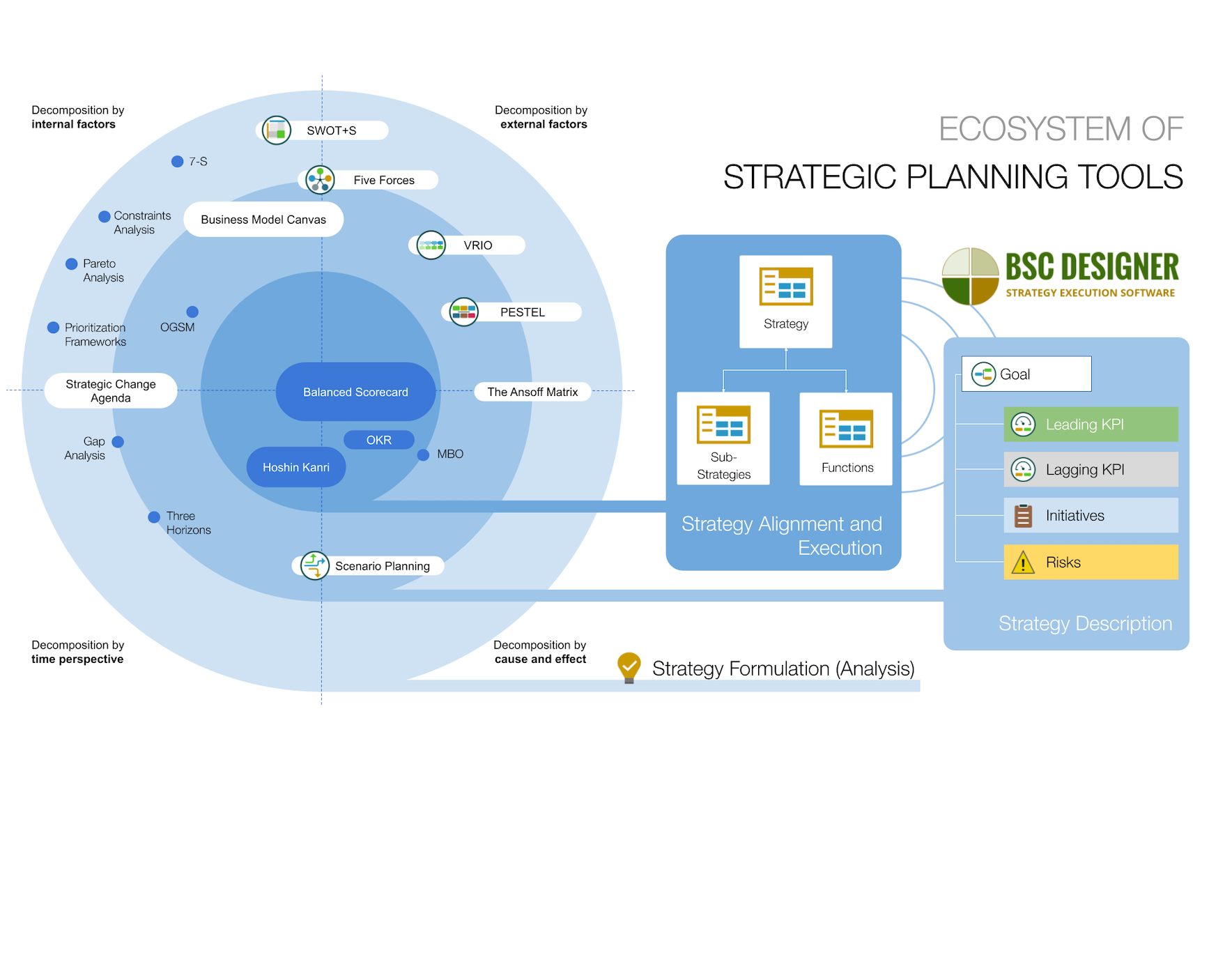Management by objectives (MBO) is a model that helps organizations improve their performance by clearly defining their objectives.
The uniqueness of this model lays in the manner in which the corporate objectives are diligently communicated down into employee objectives, to ensure the entire organization is working towards the same goal.
The core value behind management by objectives is that if the entire organization has a clear understanding of the objectives, it will help to improve commitment and participation levels, as employees will feel more empowered and involved. This will enhance performance, productivity and profits.
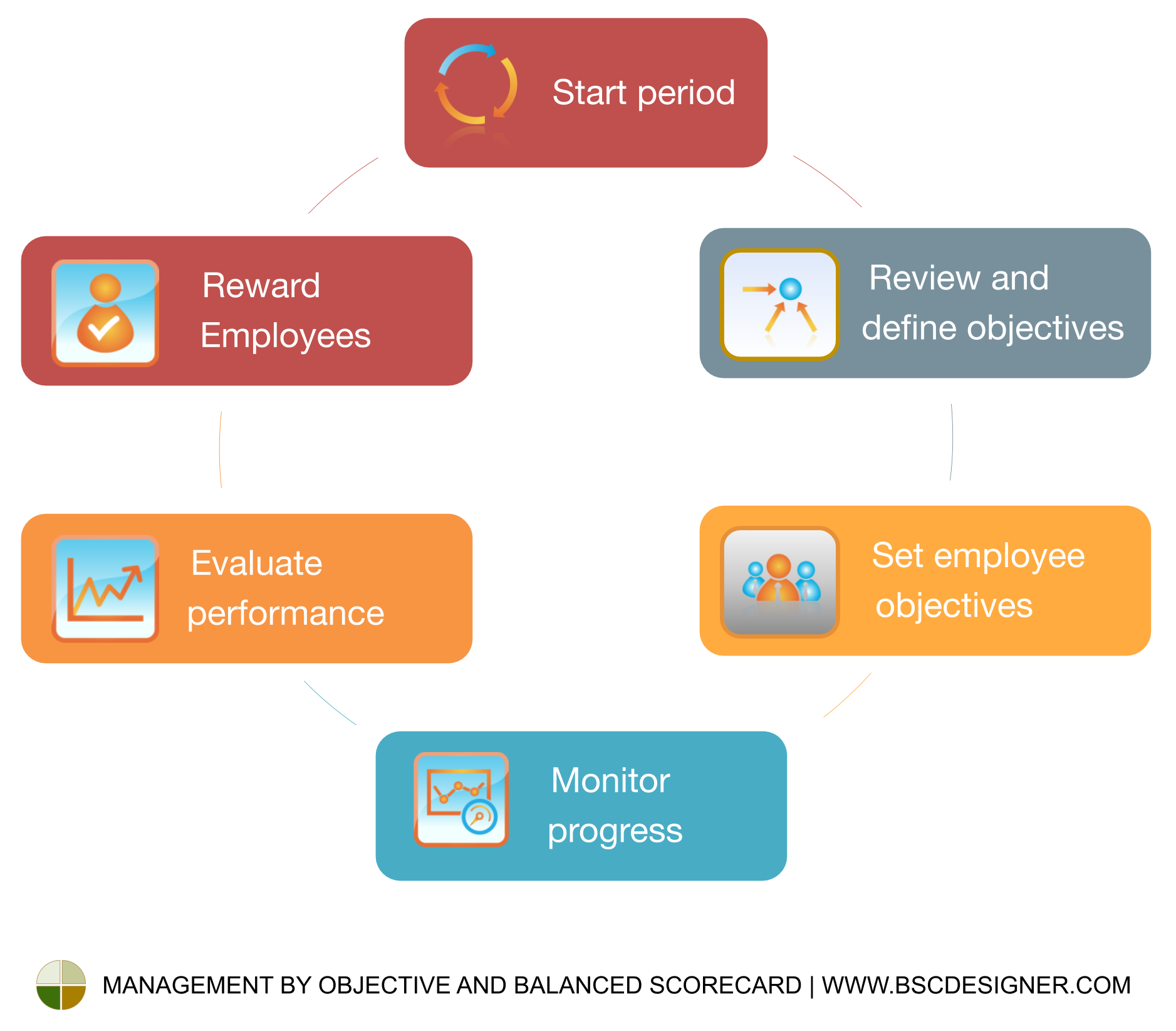
MBO – Linking Strategy with Implementation
MBO was one of the first management models that linked strategy with implementation. The traditional leadership model in the 1950s was based on leaders brainstorming goals and ordering their subordinates how to deliver those goals, with predefined activities.
When Management by Objectives was first introduced by Peter Drucker, in his ‘Practice of Management’ published in 1954 1, it revolutionized both leadership and management. He introduced MBO to ‘avoid the activity trap’ and teach organizations how to keep their workforce focused on achieving results.His student, George Odione, later developed on the subject of MBO and made it famous in the 1970s, through his ‘Management by Objectives’ book 2.
Hewlett-Packard were one of the first major companies to endorse MBO, as their top managers admitted that it helped them move away from a very hierarchical leadership to one that involved the entire organization.
However, the key to successfully implementing MBO was to actually be able to define the objectives.
Whilst this may have still have been a struggle in the 1960s and 1970s, today’s innovative management styles seem to all have MBO at their core.
How Management by Objectives Works
The model took strategy beyond the management board, with the aim to involve all employees in the organization in planning and defining corporate goals.This was implemented by simply creating strategic objectives for the organizations and communicating them down into objectives for operational teams and employees.
These objectives are reviewed periodically in order to monitor progress.
Management by objectives also works on a rewards basis, as the employees are rewarded for achieving their own objectives.
The management by objectives model is quite rigid and follows a certain pattern for its objectives. Editor's note: The OKR framework looks like another attempt to incorporate the best practices of both MBO and SMART approaches.
MBO was introduced with defined criteria for the objectives such as:
- Objectives had to be ordered according to their importance
- Objectives had to be quantitative
- Objectives had to be realistic
- Objectives had to be in line with organizational policies
- Objectives had to be compatible with each other
The 5 points is what kept the objectives well defined and suitable for corporate needs.
However, this seemed to become highly administrative and somehow restricted creativity.
More suitable models today are the SMART objectives;
- SMART stands for Specific, Measurable, Achievable, Realistic and Time.
MBO Five Step Process
MBO is also implemented on a five step process as outlined below:
- Start MBO for operational period
- Review and define corporate objectives
- Set employee objectives based on corporate goals
- Monitor progress
- Evaluate performance (at the end of the period)
- Reward employees’ achievements
Automation of MBO
Editor's note: Users of BSC Designer software can effectively automate all five steps of the MBO process:
- The operational period matches the update interval for the indicators and goals.
- Corporate level objectives can be linked to an employee scorecard (cascading) or explained by the supporting goals.
- Progress monitoring is achieved via assigning targets for the indicators and calculating performance and progress figures.
- The performance is automatically evaluated and presented via stop-lights, and additional performance analysis is possible.
- The software can automate reward calculation using indicator values in the incentives formulas.
Sign up with a free plan of BSC Designer to get started with the software.
Using BSC Designer Software for Automation of MBO
The steps below show how an MBO-style scorecard can be automated with BSC Designer software.
1. Define review period via update interval

2. Define corporate objectives
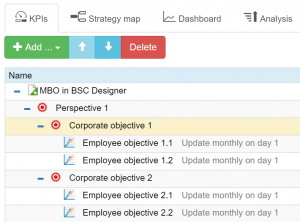
3. Set employee objectives and indicators
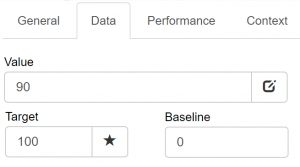
4. Monitor progress using Progress and Performance columns
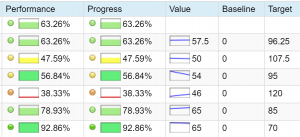
5. Do performance evaluation with the Analysis tab
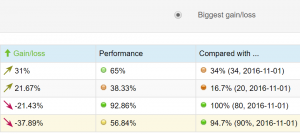
6. Use values of other indicators in the reward formulas
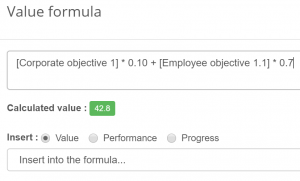
Sign up with a free account at BSC Designer Online to try all the functions without limitations.
Management by Objectives Benefits
The MBO model brings great benefits to the organization, as it enhances:
- Employee motivation
- Job Satisfaction
- Employee commitment
- Employee empowerment
- Delivery of organizational strategies
Incorporating the MBO model also helps organizations to define strategies and keep on track to achieve their desired goals. This enables organizations to focus on achieving goals and results, rather than just delivering daily tasks.The same is applied to employees, as through the MBO model they are encouraged to also work towards the bigger pictures and not fall into the daily ‘activity trap.’
Management by Objectives and the Balanced Scorecard
However, the BSC analysis seems to be an improved model of the MBO, as it takes the management one step further, where the objectives are not only periodically reviewed, but the right tools are put in place to monitor progress in real-time and make amendments where necessary.The Financial Express 4 refer to the Balanced Scorecard as ‘an extension to the management by the objectives’ model.
The MBO model was first introduced to motivate employees and drive the organization towards results. However, the rigorous objective criteria and review models sometimes turned objectives into a way to ‘catch out staff.’
On the contrary, the BSC analysis is a source of information that is built upon objectives and strategy maps to generate real time data that can be used to make informed strategic decisions. Aside from having their objective periodically reviewed, employees are now equipped with the right tools and information to take maximum control of their work and make the necessary changes in order to ensure the objectives are achieved.
The information provided by the BSC analysis takes employee motivation and commitment one step further from the MBO model, as now employees do not only have direction, but also knowledge and control over their objectives.
MBO, BSC and Organizational Goals
The MBO model has helped organizations achieve their goals and engage their workforce for the past 5 decades. Whilst many argue that MBO is best suited for knowledge-based organizations that aim to develop employees’ leadership-skills, today most companies have MBO as the core of their management. The MBO periodical reviews are very similar to the HR Annual Appraisals of today.
However, the Balanced Scorecard is a great addition or alternative to the MBO model, as it changes final reviews and evaluations for constant monitoring and control. The balanced scorecards can be shared with the entire organization and allow both employees and managers to take control over their work, make informed decision and achieve results.
Comparative Table of Strategic Planning Frameworks
- Strategy execution frameworks. Such as the Balanced Scorecard for the overall strategy and the more lightweight OKR framework for specific challenges.
- Strategy formulation frameworks. SWOT, Three Horizons, Constraints Analysis, PESTEL, Gap Analysis, etc. that help organizations to generate new ideas.
- The Practice of Management, Peter F. Drucker, 1954, HarperBusiness ↩
- ‘Management by Objectives’, George S. Odione, 1965 Pitman Pub. ↩
- Management by objectives, The Economist, 2009 ↩
- The Balanced Scorecard: An Extension Of Management By Objectives, Leslie Rebello, Director, L.R. Management Education Institute, The Financial Express, 2002 ↩
Oana Boteanu KPIs and Business Performance expert, she is a BA with Honours Management and Marketing graduate and has several years of experience working with performance management tools in employment performance and strategic performance. She also worked as a performance management online consultant at BSC Designer since from 2012 to 2013.

